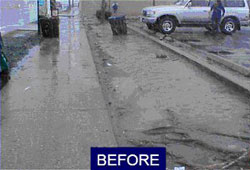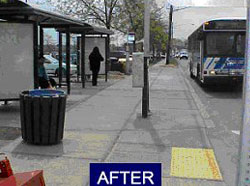Pedestrian Safety Initiative
Takoma/Langley Crossroads, Maryland
Source: Pedestrian and Bicycle Information Center (PBIC)


Problem
The pedestrian facilities surrounding the two high-traffic bus stations in the Takoma/Langley Crossroads area in Maryland were less than safe. In a 14 month period, 7 pedestrians were killed. The victims included three children, and all were Hispanic. State Farm ranked the intersection as the 3rd most dangerous in Maryland.
Background
The Takoma/Langley Crossroads area in Maryland is home to a large transient Hispanic population who rely on the bus system for their daily commute. In fact, the area bus system issues more transfers than any other Prince George's County station not yet served by a metro station. The location was a challenging area to initiate projects, as the neighborhood sits on the border lines between three separate jurisdictions: Prince Georges County, Montgomery County, and the City of Takoma Park. Due to the transient nature of much of the local population, there were no clear community organizations or neighborhood associations with whom to work.
Solution
It took the leadership of a retired local business owner to initiate a pedestrian safety project. The former Government Commissioned Task Forces had collapsed when overall streetscape project funding was cut and projects that cost in the tens of millions were shelved. The challenge was then to piece together smaller projects, and this required multiagency coordination. Citizen advocate Erwin Mack learned who to contact and who was responsible for what, and prodded the jurisdictions to take action. The Pedestrian Safety Advisory Committee was formed with representatives from each jurisdiction to avoid the duplication of efforts or projects. The group met bimonthly and the retired citizen advocate provided the group with lunch and encouraged their efforts. As one planner involved commented, "All the money in the world can't buy you a volunteer, and all the money in the world couldn't have hired a better coordinator to lead the meetings."
Bilingual focus groups were held early on to solicit community input. Some of the comments by Latinos suggested that many of them were unfamiliar with traffic rules here, as rules are generally much less enforced in their native country. Additionally, participants complained that traffic moved more quickly here and that there was inadequate time to cross intersections.
Measures taken include pedestrian crossing signs, marked crosswalks, improved street lighting, and medians with channelized fences. Seven signalized areas are being reconstructed to include pedestrian activated signals, curb cuts, and ramps. At a distance of 1 mile from the intersections, overhead mast arms with flashing beacons and a "pedestrian area, next mile" sign have been installed on all corridors. Currently under negotiation is the land for the location of a new bus transfer area that will provide 12 bus spaces and eliminate the need to cross major roads to make transfers.
Business leaders were either champions or strong critics. Erwin Mack, a local business owner, provided leadership and even started the Crossroads Development Authority to organize business support. Another installed a perimeter fence at his own cost to help channel pedestrians. However, the issue of developing the bus transfer center is still being negotiated with the property owners of the chosen site.
Funding initially came through state programs and the Community Design Division to fund specific parts of the effort, such as safety or resurfacing. Each county later agreed to a request to contribute $2.5 million towards the transit center. In addition, the state set aside Consolidated Transportation Program funds for transit-related improvements for the Maryland Transit Administration (MTA). Improvement costs totaled nearly $20 million.
In addition to physical improvements, there have been quarterly pedestrian crosswalk enforcement events, during which education materials are handed out. These efforts have were organized by a county non-profit organization, C-SAFE — a Hot Spots Community Initiative dedicated to safety and crime prevention, and supported by the Governor's Office of Crime Control and Prevention and several other local agencies. The group recruits volunteers from nearby colleges and the Prince George's County Office of the Executive Hispanic Liaisons as well.
Results
A sense of place has been created in a previously auto-centered commercial area. The physical improvements have all been installed and the new bus transfer station is confirmed, with secured funding and only the details to be worked out to attain parcels of property.
Contact
Stephanie Yanovitz
Maryland DOT
(410) 545-5668
syanovitz@sha.state.md.us
Image Source
"Pedestrian Safety -Takoma/Langley Park." District 2 Annual Meeting, Institute of Transportation Engineers. May 11th, 2006.




